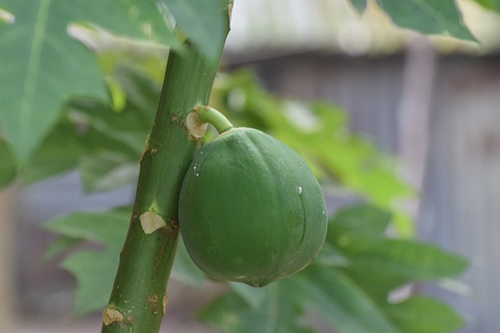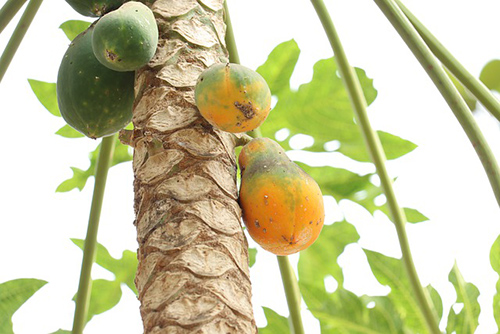Contents

The fruit of the papaya tree is one of the most appreciated fruits of all tree products in America. Thus it is not strange it receives so many different names.
Papaya Tree Scientific Facts
- Other names: Melon tree.
- French: Papayer.
- Spanish: Papaya.
- Environment: Indigenous to Mexico and spread on tropical lowlands in America, Africa, and Asia.
- Description: Dioicous tree of the Caricaceae family, growing from 4 to 6m high, with cylindrical unbranched trunk from whose upper part fruits and leaves grow. Trees with male flowers do not render fruit.
NOTE! Papain is an ingredient in several pharmaceutical formulations. It is used in orthopedic surgery to dissolve the nucleus of the intervertebral disk in the case of a slipped disk.
Healing Properties and Indications

The latex and the leaves of the papaya tree contain papain, a protein-splitting enzyme, able to hydrolyze proteins, liberating the amino acids they consist of. Papain acts similarly to pepsin and tripsin, both enzymes contained in the gastric and pancreatic juices.
The latex and the leaves are recommended for people suffering from a lack of digestive juice, usually caused by chronic gastritis or pancreatitis. Because of their vermifuge properties, they are also helpful against intestinal parasites, especially tapeworms.

Papayas, the fruit of the papaya tree, is rich in vitamins A and C, and though they do not contain papain, they invigorate digestion and normalize intestinal functioning. Consumption of papayas is highly recommended for colitis, irritable bowel syndrome, and chronic constipation.
How to use Papaya
- Latex: It is obtained through incisions in the green fruits and the trunk of the papaya tree. Take 10-20g mixed with honey and warm water after each meal, then a strong laxative when a vermifuge is needed.
- Infusion, with thirty grams of leaves per liter of water. Drink three cups daily.
DISCLAIMER: All content on this website is presented solely for educational and informational objectives. It would be best to not rely on the information provided as a replacement for advice, diagnosis, or treatment from a qualified medical expert. If you are pregnant, nursing, or have any preexisting medical concerns, you should talk to your doctor before using any herbal or natural medicines.
REFERENCES
- George D. Pamplona-Roger, M.D. “Encyclopedia of Medicinal Plants.” George D. Pamplona-Roger, M.D. Encyclopedia of Medicinal Plants. Ed. Francesc X. Gelabert. vols. 2 San Fernando de Henares: Editorial Safeliz, 2000. 435. Print.
- Harvard Health: https://lpi.oregonstate.edu/mic/vitamins/vitamin-A
- Nutrients: https://www.ncbi.nlm.nih.gov/pmc/articles/PMC3827527/
